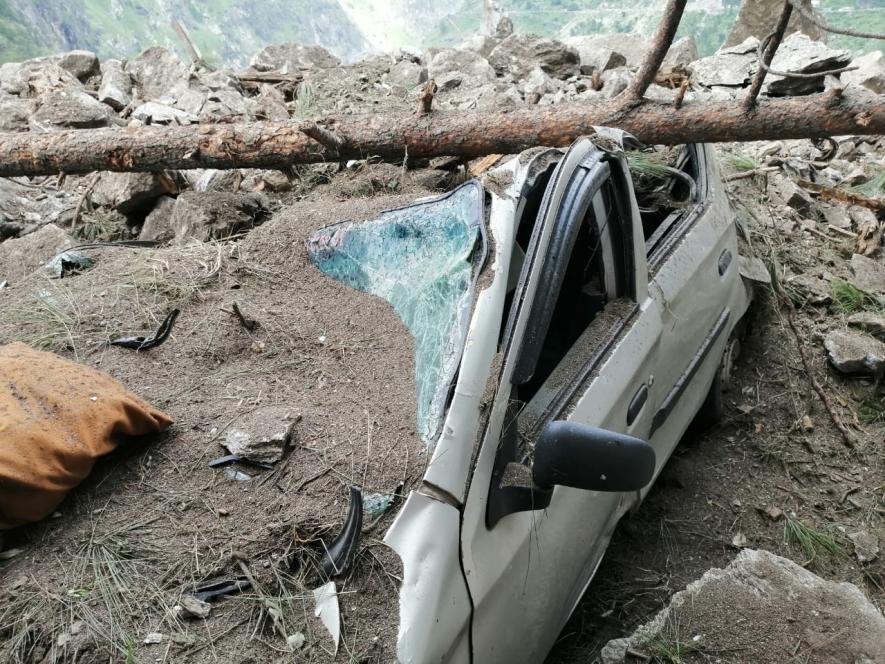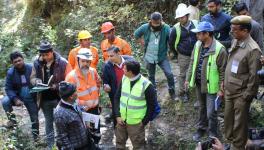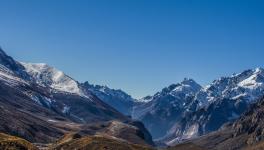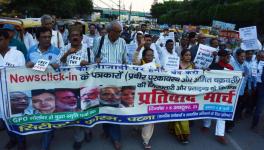Unscientific Road-Building Triggers Yet Another Himalayan Landslide

The drive from the hill stations of Solan to Nahan on the National Highway 7 in Himachal Pradesh is an eye-opener. There are stacks of felled trees, some half-a-kilometre long, lined along the carriageway every few kilometres. The concomitant of all this tree-cutting is that the mountain slopes look bare and desolate, devoid of shrubs and plants and trees that hold the soil.
As expected, two days after we drove along this road, we received a Whatsapp video of a significant landslide (150 metres) that took place on July 30 near the Kali Dhank village in the Sirmaur district of Himachal Pradesh (National Highway 707, Paonta to Shillai). The landslide has adversely impacted thousands of villagers of the 50 panchayats in this area, who are now struggling to access basic facilities. The road is likely to remain blocked for another fortnight, bringing all traffic on this route to a halt.
The NH7 goes past village Badwas in Nahan, where another landslide occurred around the same time. Fortunately, no casualties were reported from here. A team of scientists sent by the Geological Survey of India who visited the Kali Dhank site on August 3-4 blamed limestone quarrying at the base of the hills for triggering the cave-in. The GSI team has suggested measures to strengthen the slope, but it will take years before this hillside regenerates.
The fact is that landslides have become the norm in the Himalayas. News has come in of a major landslide that has buried 40 people under debris in the Kinnaur district of Himachal Pradesh. Thirteen bodies have been recovered, and another 30 remain buried. A few weeks ago, nine tourists were killed and three injured in multiple landslides in this district.
Rapid road construction and road expansion are being pursued without paying heed to social and environmental consequences. Frequent use of dynamite, incorrect slope-cutting and indiscriminate dumping of muck has created a situation where locals who had earlier pressed for connectivity now complain bitterly about how road-building is causing loss of life and livelihoods.
People living in the villages along the 900-km Char Dham road are up in arms, agitating and holding dharnas at regular intervals. The Char Dham Pariyojana has a special prestige within the ruling party because it involves building a road to the Yamunotri, Gangotri, Kedarnath and Badrinath pilgrimage centres.
Former Uttarakhand minister Dinesh Dhanai held a day-long dharna in Tehri district last week, protesting against the indiscriminate dumping of debris. “This pool of muck is now flowing into homes and farms and destroying crops,” Dhani said, complaining that this had become an annual feature during the rainy season.
Sushila Bhandari, along with a team of dedicated environmentalists living in the villages dotting the Kedarnath valley, is also battling the fall out of the Char Dham expansion. “Contractors use dynamite for road expansion and to build tunnels for local hydroelectric projects. The result is we villagers face more and more landslides. We are terrified to leave home and remain confined inside for weeks. Several villagers have died and others injured but we have no exact figures because the administration refuses to release the full list,” says Bhandari.
Bhandari was jailed for 54 days while agitating against the construction of the Tehri Dam. The judge asked her to seek bail. She refused, saying she was fighting to save the Himalayas and its ecology and, if need be, was willing to spend the rest of her life in jail. “The road construction and over 500 hydro-projects, accompanied by a network of tunnels, has hollowed out the Himalayas. Village after village has been destroyed. Ancient trees and foliage have been cut,” she says in a voice heavy with sorrow.
Kedarnath, however, is still a popular destination among BJP leaders. “When Home Minister Amit Shah came to Kedarnath, a group of activists went to meet him. He assured us that no dynamite would be used in these mountains but it has not stopped. I have taken videos of how rules are being flouted and sent it to him to little avail,” she laments.
An environmentalist with the NGO Ganga Avahan, Hemant Dhyani, believes that road construction must maintain a delicate balance with the environment, especially in the hills. “Scientists believe the Himalayan terrain can support roads up to 5.5 metres wide. Up to 2018, this was the norm followed by the government. The decision to extend the width of the Char Dham to over 10 metres is linked to allowing the Ministry of Road Transport to levy a 60% toll tax on this road,” he says. “Sadly, widening further destroys these slopes,” says Dhyani.
Environmental activists maintain that initially, villagers were not opposed to the massive push to road construction or widening under the Prime Minister Sadak Yojana (PMSY) in Uttarakhand and Himachal Pradesh. They became increasingly suspicious when the Ministry of Road Transport proceeded with the Char Dham project without environmental clearances.
“The Ministry of Road Transport has allocated Rs. 12,000 crores to widen the 900 kilometre Char Dham road, which works out to more than Rs. 8-10 crore per kilometre. In other PMSY projects, the budget is around Rs. 80 lakh per kilometre,” says Dhyani.
Mallika Bhanot, also with Ganga Avahan, works closely with villagers affected by landslides. She says, “The hills are getting cut much steeper than recommended. However, measures to protect the slopes, such as protection walls, are much lower than recommended. Sadly, there are no catch drains to divert seepage along the slopes into the nearest drain. They are wreaking havoc on the Himalayas.”
Bhandari and other concerned villagers filed a PIL in the Nainital High Court three years ago. Their petition warned that “any further cutting of the mountain base for widening or tree felling would cause unprecedented activation of landslides”. They wrote that even the existing highways could get blocked if this happens, which would be “counter-productive even for the normal traffic flow”. It seems they have been proved correct.
After every landslide, the NDRF and ITBP teams come to help rescue people and file a review that attributes reasons for the landslide. A senior NDRF official says, on condition of anonymity, that the growing number of landslides is due to climate change and increased anthropogenic activity. However, he said no preventive steps are listed out to stop such events.
Reenu Paul, a Dehradun-based social activist who has petitioned for a halt to indiscriminate road construction in Uttarakhand, says, “There has to be an overall co-ordinated plan to construct roads. We are witnessing a strange phenomenon where, due to political influence, some villages are being connected by multiple roads.” Paul cites Maldevta and Thatyud villages to emphasise this point.
Dr Vikram Gupta, a scientist with the Wadia Institute of Himalayan Geology in Dehradun, says road construction and widening in Uttarakhand follow no standard operating procedures. “Once a mountain slope is cut, it must be immediately protected. Sadly, in our state, no procedures are followed. Naturally, these slopes will fail and it is not surprising that we have regular landslides around the year,” says Gupta.
He says, “A group of scientists including I studied 44 landslide-susceptible zones in Himachal Pradesh from which five were extremely unstable. But the problem in Himachal has got attenuated by climate change and concentrated rainfall.”
Vikram Soni, Professor Emeritus at JNU and a physicist and environmentalist, is horrified at the unplanned road expansion in mountainous areas. “On the Chinese side, the Himalayas are [made of harder] rock but on the Indian side, it is largely shale, which is a weak sedimentary rock. The ecology around these roads including the tree cover and the grasses and shrubs that bind the soil will take 30 years to recover. And on mountain slopes where two roads have been built, the slope may never recover,” says Soni.
History tells us that Char Dham was a pilgrimage on foot, a chance to commune with nature. “Here, they have become highway pilgrimages. All one gets out of going to these places is diesel fumes,” said Soni.
The 400% increase in black carbon deposits recently detected on the Gangotri glacier results from vehicular traffic. Given the severe consequences of climate change, we need to give valleys a rest so that they can regenerate. Road-building and excessive tourism need to be curbed.
The author is a freelance journalist. The views are personal
Get the latest reports & analysis with people's perspective on Protests, movements & deep analytical videos, discussions of the current affairs in your Telegram app. Subscribe to NewsClick's Telegram channel & get Real-Time updates on stories, as they get published on our website.
























